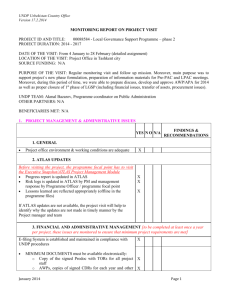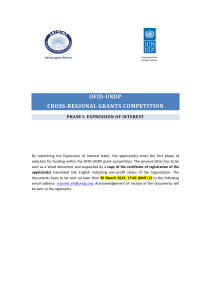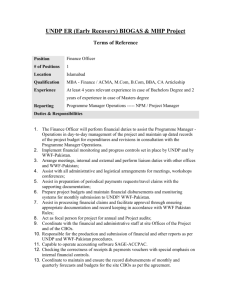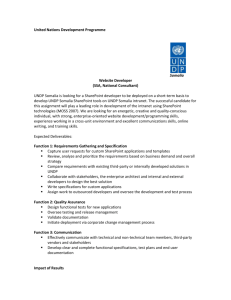dp2013-42
advertisement
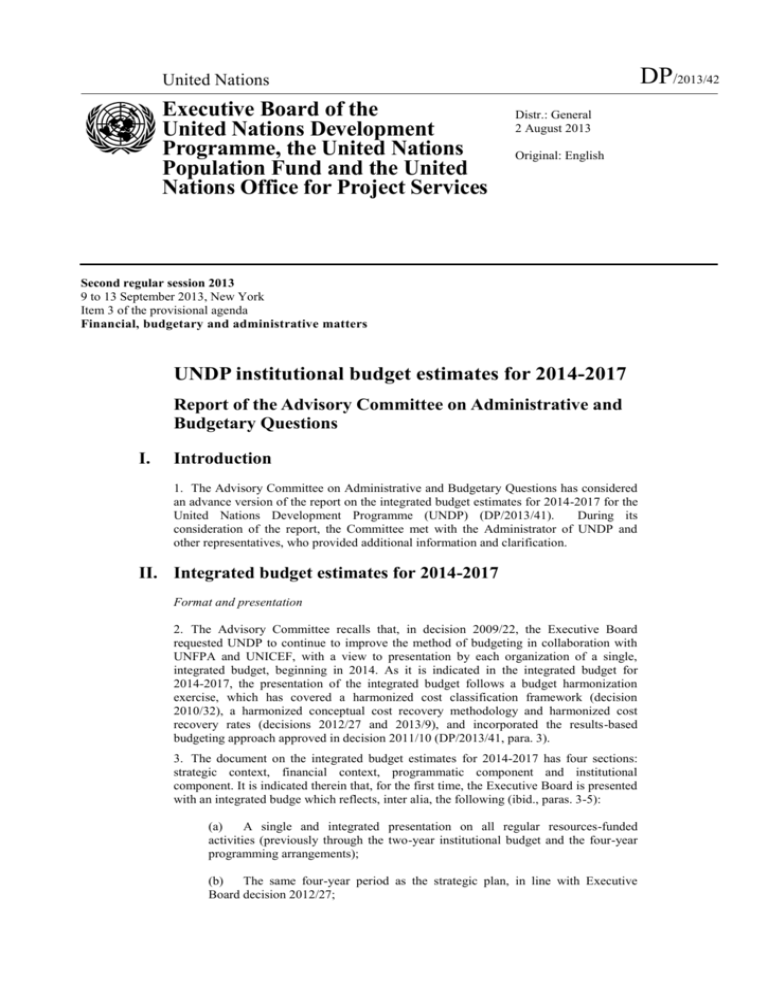
DP/2013/42 United Nations Executive Board of the United Nations Development Programme, the United Nations Population Fund and the United Nations Office for Project Services Distr.: General 2 August 2013 Original: English Second regular session 2013 9 to 13 September 2013, New York Item 3 of the provisional agenda Financial, budgetary and administrative matters UNDP institutional budget estimates for 2014-2017 Report of the Advisory Committee on Administrative and Budgetary Questions I. Introduction 1. The Advisory Committee on Administrative and Budgetary Questions has considered an advance version of the report on the integrated budget estimates for 2014-2017 for the United Nations Development Programme (UNDP) (DP/2013/41). During its consideration of the report, the Committee met with the Administrator of UNDP and other representatives, who provided additional information and clarification. II. Integrated budget estimates for 2014-2017 Format and presentation 2. The Advisory Committee recalls that, in decision 2009/22, the Executive Board requested UNDP to continue to improve the method of budgeting in collaboration with UNFPA and UNICEF, with a view to presentation by each organization of a single, integrated budget, beginning in 2014. As it is indicated in the integrated budget for 2014-2017, the presentation of the integrated budget follows a budget harmonization exercise, which has covered a harmonized cost classification framework (decision 2010/32), a harmonized conceptual cost recovery methodology and harmonized cost recovery rates (decisions 2012/27 and 2013/9), and incorporated the results-based budgeting approach approved in decision 2011/10 (DP/2013/41, para. 3). 3. The document on the integrated budget estimates for 2014-2017 has four sections: strategic context, financial context, programmatic component and institutional component. It is indicated therein that, for the first time, the Executive Board is presented with an integrated budge which reflects, inter alia, the following (ibid., paras. 3-5): (a) A single and integrated presentation on all regular resources-funded activities (previously through the two-year institutional budget and the four-year programming arrangements); (b) The same four-year period as the strategic plan, in line with Executive Board decision 2012/27; DP/2013/42 (c) A four-year period resource projections, with a midterm review focusing on the financial estimates of institutional component of the integrated budget (in conjunction with the biennial update on programmatic components); and (d) The results-based budgeting approach, including: (i) improved results focus and linkage with the strategic plan; and (ii) harmonized budget tables with respect to the integrated resource plan (tables 1a and 1b), and an integrated results and resources framework (annex 1). Midterm review 4. The Advisory Committee notes that, according to the decision by the Executive Board (2012/27, para.11), the resource projections and the integrated budget for all cost categories will cover a four-year period, coinciding with the duration of each organization’s strategic plan, and that the integrated budget will be reviewed together with the midterm review of each organization’s strategic plan. 5. Upon enquiry, the Advisory Committee was informed that in line with the applicable provisions of UNDP's Financial Regulations and Rules, in particular regulation 13.09, the Administrator, in preparing supplementary proposals to amend the institutional budget, shall do so in a form consistent with the approved institutional budget and shall submit such proposals to the Executive Board. They shall also be submitted to the Advisory Committee, which is requested to review them and report thereon to the Executive Board. IPSAS and multi-year budgeting 6. The Advisory Committee was informed, upon enquiry, that standard 24 of the International Public Sector Accounting Standards (IPSAS) recognizes that entities approve and make publicly available multi-year budgets rather than separate annual budgets. According to the standard, in the case where an entity passes a biennial or other multi-period budget that does not specifically separate budget amounts into each annual period, judgement may be necessary in identifying which amounts are attributable to each annual period in determining annual budgets for the purposes of this standard. In this regard, according to UNDP secretariat, it has an established methodology to determine annual budgets for internal management purposes, noting that the budget approved by the Executive Board represents a planning instrument providing a longer-term perspective. This methodology was applied to the statement of comparison of budget to actual amounts in UNDP's financial statements for the year ended 31 December 2012. 7. At the time of its consideration of UNDP institutional budget for 2012-2013, the Committee welcomed the progress made by UNDP in the implementation of resultsbased budgeting and urged UNDP to continue its efforts in this regard in collaboration with UNFPA and UNICEF. The Committee expressed its trust that subsequent UNDP integrated budgets would reflect the envisaged changes, including the harmonized classifications of activities and associated costs, as well as improved linkages between results in strategic plans and resources required to achieve the results, along with expenditure data for the previous biennium for comparison purposes (DP/2011/35, para. 15). In this connection, the Committee welcomes the efforts made and progress achieved by UNDP in the budget harmonization exercise, including the improved alignment between resources with the strategic plan and the provision of expenditures for 2012-2013 for comparison purposes. 8. With respect to the four-year resource projections contained in the proposed integrated budget, the Advisory Committee notes that projections for the institutional component reflect budget estimates for 2014-2015 and notional estimates for 2016-2017 (ibid., table 3). Recognizing inherent uncertainties associated with the resource projections and costing assumptions over a four-year period, the Advisory Committee considers that the midterm review to be conducted in 2015 will be an important opportunity to assess the integrated budget formulation and its 2 DP/2013/42 implementation, as well as to consider budget estimates for 2016-2017. The Committee, therefore, looks forward to the midterm review of the integrated budget for 2014-2017. 9. Furthermore, while recognizing that UNDP has incorporated the results-based budgeting approach in its integrated budget as approved by the Executive Board, the Advisory Committee, nonetheless, requests that UNDP provides to the Committee information on major items of expenditure under post and non-post resources, as supplementary information, to facilitate its future consideration and better analysis of UNDP institutional component of the integrated budget. Overall resource requirements 10. Figure 1 in the budget document provides an overview of actual and estimated contributions from 2008-2009 to 2016-2017 by funding category. The projected total contributions for 2014-2017 amount to $19,359 million, comprising (ibid. para. 7 and table 1a): (a) Regular resources of $3,600 million ($1,750 million for 2014-2015 and $1,850 million for 2016-2017); (b) Other resources of $12,759 million ($6,250 million for 2014-2015 and $6,510 million for 2016-2017); and (c) Local resources of $3,000 million provided by host governments ($1,500 million for each biennium). 11. The integrated resources plan for the period 2014-2017 presented in table 1a covers regular and other resources, which reflects cost classification categories approved in decision 2010/32 and contains cost recovery in line with the harmonized format for the integrated resources plan (ibid. para. 9). The breakdown of the estimated total expenditures of $22,641.7 million for 2014-2017 is provided in figure 2a and table 1a, which consist of the following: (a) Development activities: $20,111.6 million, or 88.8 per cent; (b) United Nations development coordination activities: $370.6 million, or 1.7 per cent; III. (c) Management activities: $1,836.3 million, or 8.1 per cent; and (d) Special purpose activities: $323.2 million, or 1.4 per cent. Institutional component of the integrated budget 12. The estimated institutional component for 2014-2017 of the integrated budget amounts to $1,359.6 million, representing $713 million for 2014-2015 (budget estimates) and $646.6 million for 2016-2017 (notional estimates). An overview of the proposed institutional component by cost classification category for 2014-2015 and 2016-2017 is presented in table 3 of document DP/2013/41. While more detailed information is provided for 2014-2015 estimates to facilitate a comparison with activities in the 2012-2013 institutional budget, estimates for the 2016-2017 period are premised on 2014-2015 estimates (ibid., para. 41). Budget estimates for 2014-2015 13. The budget estimates of $713 million for 2014-2015 reflect a net reduction of $143.5 million, or 15.4 per cent, compared with the approved budget of $856.5 million for 2012-2013. According to UNDP, the proposals reflect a deliberate reduction in the 3 DP/2013/42 proportion of regular resources allocated to the institutional component in favour of programmatic component (ibid., table 4, paras.42 and 43). 14. A summary of the main areas of increase and decrease in 2014-2015, compared to 2012-2013, is presented in table 4, which shows the following (ibid., paras. 45-47): (a) Reductions totalling $173.5 million, or 18.6 per cent, reflecting (i) an alignment with projected voluntary contribution levels ($66.5 million); (ii) the implementation of decision 2013/9 on cost recovery ($97 million); and (iii) the completion of non-recurring investments introduced in 2012-2013 related to the enhancement of value-added corporate services, with respect to the implementation of IPSAS, and information and communications technology activities ($10 million); (b) The reductions are offset in part by increases in (i) $25 million (2.7 per cent) in non-discretionary cost (including inflation and currency adjustments), compared with the cost increases for 2010-2011 (10.7 per cent) and 2008-2009 (15.1 per cent); and (ii) $5 million (0.5 per cent) to support the implementation of the change agenda (such as investments in the development of stronger knowledge systems, country office business models, business analytics, and results-based management). No cost increases are proposed for reclassifications of posts for 2014-2017. 15. In addition and following prior practice, UNDP is requesting an exceptional authority to disburse up to $30 million for 2014-2017 in regular resources for security measures which would be limited to new and emerging security mandates as defined in United Nations Department of Safety and Security directives. UNDP will report on the use of the security provision as and when such would occur (ibid., para. 44). Post requirements 16. The integrated budget for 2014-2017 includes a proposed envelope of $568.7 million in regular resources for 2014-2015 and $519.9 million for 2016-2017 to finance the D-1 and higher grades, as well as, in combination with other resources, requisite institutional capacities at P-5 and lower grades that fulfil functions in support of the UNDP mandate. This represents a reduced financing envelope compared to the prior period ($568.7 million in 2014-2015 compared to $672.5 million in 2012-2013) (ibid., para. 58). According to UNDP, the integrated budget incorporates a strategy for financing personnel costs with respect to positions at grade P-5 and below in a manner that more accurately reflects the results framework and the underlying funding sources of the requisite activities by using multiple funding sources. Further, this leads to a more strategic and efficient use of regular resources, allowing UNDP to allocate a greater share to development activities (ibid., para. 55). 17. Upon enquiry, the Advisory Committee was informed that, being financed from a combination of regular and other resources, UNDP is proposing a strategy for financing personnel costs with respect to grades P-5 and below that would more accurately reflect the underlying results frameworks and the multiplicity of funding sources used to achieve those results. UNDP believes that this would lead to a more strategic, efficient and proper use of regular resources and minimize cross-subsidization of activities funded from other resources. This approach would not reduce the control on the level of regular resources allocated to positions, as control would be exercised at the resource envelope level, thus ensuring that organizational units, and UNDP as a whole, would remain within an approved budget. As it has been done in the past, UNDP would also make requisite adjustments based on the volume of voluntary contributions (utilization of the resources is reported on an annual basis in UNDP's audited financial statements). 18. The Advisory Committee enquired as to how the new funding strategy would be implemented, including its review process, and was informed that this would be done through UNDP’s on-line internal strategic planning tool, whereby integrated annual 4 DP/2013/42 workplans and resource requirements to fulfil the plans are prepared each year by all country offices and all units at headquarters bureaux. Starting in 2014, the integrated workplan for each unit would include a funding proposal for all posts (as opposed to the current single-funding source). The integrated workplans would be reviewed and approved by the responsible regional bureaux (in the case for country offices) or headquarters bureaux (in the case for headquarters units). Through this process, the Bureaux would determine the level of the regular resource allocation to each unit from the approved resource available. All integrated workplans would be approved by the Administrator, ensuring that UNDP, as a whole, would remain within the authorized budget. Through this integrated work planning process, funding sources would be reviewed, and adjusted if necessary, annually. The Advisory Committee expects that UNDP will closely monitor and assess the implementation of the proposed funding strategy and report the progress in the midterm review of the integrated budget in 2015. Income and government contributions towards local office costs 19. The total income to the institutional component for 2014-2015 is estimated to be $75.4 million from three sources: (a) government contributions towards local office costs ($52.6 million); (b) income derived from United Nations Volunteers programme by providing volunteers to other United Nations organizations ($5 million); and (c) voluntary contributions to offset the cost of reimbursing income taxes paid by United Nations staff on their salaries ($17.8 million) (ibid., paras. 48 and 49). 20. Table 5 in the budget document shows 2012 government contributions towards local office costs (GLOC) at $42.8 million (against a total obligation of $68.4 million), representing a 63 per cent compliance rate, compared with a 75 per cent rate in 2010. UNDP indicates that, while it appreciates improvements made by programme countries toward meeting their obligations with respect to GLOC, middle-income country compliance remains at a less-than-desirable level, and UNDP will maintain the option to withhold part of institutional budget resources for countries with significant deficits, with an emphasis on middle-income countries (ibid., paras. 50 and 51). 21. Upon enquiry, the Advisory Committee was informed that the last time UNDP in practice withheld part of the institutional budget resources, due to non-payment of GLOC, was in the 2000-2001 biennium. The reductions were made exclusively on operating costs, but not on any staff positions. Though UNDP has consistently maintained, since 2003, the option of withholding a portion of institutional budget resources from countries with significant GLOC deficits, that option has not been exercised, in particular due to the potential impact on development results, especially in least-developed countries and low-income countries. UNDP, however, proactively monitors GLOC performance, and sends reminders for payments due to programme country governments. The Advisory Committee is of the view that UNDP may wish to exercise the option regularly, in particular in situations where countries concerned are clearly in a position to meet their obligations. Harmonized cost recovery methodology and transitionary funding for management activities 22. The harmonized cost recovery methodology and its implications are discussed in paragraphs 59 to 61 and annex II to the integrated budget document. A number of legislative changes with respect to the cost recovery methodology have been adopted by the Executive Board: decision 2010/32 endorsed harmonized cost classification categories, and subsequent decisions 2012/27 and 2013/9 endorsed a harmonized methodology for calculating cost recovery rates, effective 2014. Consequently, the share of cost recovery resources allocated to institutional activities in 2014-2017 has been increased. Planned expenditures funded from other resources would increase from 5 DP/2013/42 1998-1999 ($121 million, or 19 per cent) to 2014-2015 ($720.1 million, or 50.3 per cent) and 2016-2017 ($749.2 million, or 53.7 per cent). 23. In this connection, UNDP indicates that provisions for transitionary funding are required due to the transition time needed before the new cost recovery methodology is in full effect and cost recovery resources can be prioritized to finance management activities (ibid., paras. 62-65). It is, therefore, proposed to have provisions of $132.8 million for 2014-2015, and $66.4 million for 2016-2017 which will be reviewed in 2015 by the Executive Board. UNDP will assess progress made in implementing the cost recovery rates endorsed in decision 2013/9, as well as approaches to financing development effectiveness activities, which will be factored in to the review of the cost recovery policy in 2016 in accordance with decision 2013/9. 24. The Advisory Committee notes the progress achieved in the harmonized cost recovery methodology and welcomes the increasing proportion of the institutional budget to be funded from other sources as a result of the harmonization exercise. The Committee expects further update on this issue in the context of the midterm review of the integrated budget in 2015. United Nations development coordination activities 25. It is indicated in the budget document that, in response to General Assembly resolution 67/226 on the quadrennial comprehensive policy review of operational activities for development of the United Nations system, the UNDG Principals Advisory Group in April 2013 reached a critical breakthrough agreement on a system-wide cost-sharing of the resident coordinator system based on a centralized, predictable funding modality to replace ad hoc arrangements and requests for funds. The agreement provides for core minimum coordination capacity to United Nations country teams based on a typology of countries, the regional UNDG teams and the Development Operations Coordination Office as the UNDG secretariat (ibid., para. 68). Resources for the United Nations development coordination activities are thus proposed at a level of $242.3 million for 2014-2015, reflecting an increase of $8 million over the 2012-2013 estimated level of $234.3 million. A breakdown of the resources is provided in paragraphs 69 and 70 of the integrated budget. 26. Upon enquiry, the Advisory Committee was informed that the three main factors that had impact on UNDP’s proposal for the United Nations development coordination activities for 2014-2015 were the General Assembly resolution, the subsequent cost-sharing agreement reached amongst UNDG members and the implementation of harmonized cost recovery methodology. First, according to the resolution, the resident coordinator system, while managed by UNDP, is owned by the United Nations development system as a whole and that its functioning should be participatory, collegial and mutually accountable within that system. Second, following the cost-sharing agreement, UNDP, as steward of the RC function, will (a) continue to fully fund the ‘backbone’ costs (a biennial amount of $176.3 million) of the System at the country, regional and global levels; and (b) participate in the cost-sharing formula for the supplemental costs of $66 million for the biennium on an equal footing as all UNDG members, and consequently UNDP’s total funding towards UNDC will increase by an amount of $8 million. Third, the United Nations development coordination activities are excluded from the harmonized cost recovery methodology as these costs apply primarily to UNDP in carrying out its stewardship of the United Nations resident coordinator function. Special purpose activities 27. Special purpose activities include non-UNDP operations administered by UNDP (UNV and UNCDF) and capital investments (ibid., para. 71). For capital investments, two capital expense plans are considered high-priority and resources are therefore provided for (a) information and communications technology upgrades and 6 DP/2013/42 optimizations; and (b) leasehold improvements. In line with harmonized cost classification definitions, a provision of $59.2 million ($18.3 million in regular resources and $40.9 million in other resources) is reclassified from the management category to the special purpose category with respect to capital investments (ibid., paras. 77 and 78). 28. The Advisory Committee recommends that the Executive Board approve the proposed institutional component of the integrated budget for 2014-2017. IV. Other matters 29. The Advisory Committee requested information on the progress and preliminary findings of the structural review, including potential impact on the regional bureaux. The Committee was informed that the Administrator had commissioned a review of UNDP's structure, to support the organizational effectiveness, efficiency, and agility required to deliver on the new strategic plan, which would be done within the resource envelope outlined in this budget. The review was presently in the initial phases, where information was being collected covering UNDP's institutional activities, and as such, there were not yet any preliminary findings at this time. The Committee notes from the information it received upon request that a number of posts at the D-1 and the D-2 levels are vacant, which, according to UNDP, are to remain vacant pending the broader review of UNDP’s structure. The Advisory Committee looks forward to the findings of the structural review in the context of the midterm review of the integrated budget in 2015. 30. The Advisory Committee requested information on UNDP’s policies related to allocation of information and communication technology equipment and vehicles to staff. The Committee was informed that UNDP staff are provided with access to the equipment based on business needs. Laptops/tablets are the first choice over desktops due to mobility and business continuity capabilities and users are restricted to having only two mobile devices in order to stem the rising costs. ICT policies and standards are established at HQs level and are updated every twelve months. Moreover, laptops and tablets have an expected replacement cycle of four years and any exceptions to this rule have to be based on UNDP business need and require approval at the Director level. 31. With respect to vehicles, the Advisory Committee was informed that each country office is normally entitled to providing official vehicles to the Resident Representative and Resident Coordinator (where applicable), plus one vehicle for every three professional staff members. As a minimum, country offices are allowed to have three vehicles (four where a position for a Resident Coordinator exists): one as the official vehicle for the Resident Representative, one for the administrative/finance function, and one for the programme function. 32. Noting that UNDP updates relevant policies and standards every twelve months, the Advisory Committee requests that UNDP provides, to the Committee, the most up-to-date information with respect to the information and communications technology equipment and vehicle allocations, as supplementary information to the integrated budget in the context of the midterm review in 2015. 7



